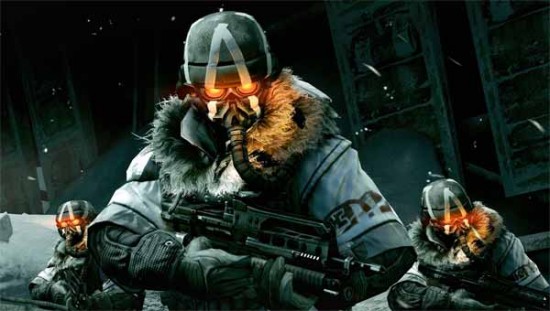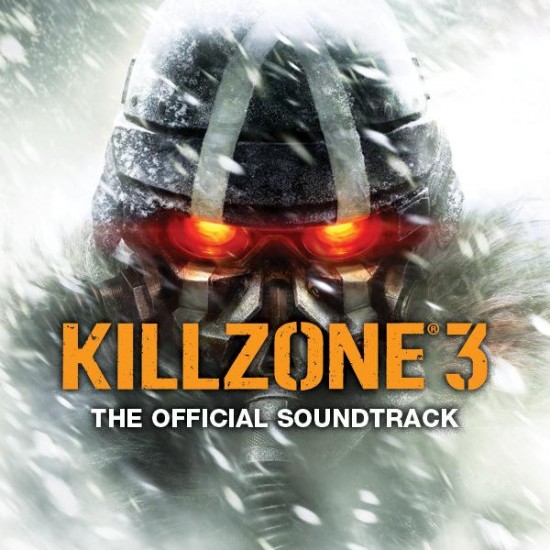Joris de Man holds a special place in our music-nerdy little hearts. Aside from giving us some high quality soundtracks in the Killzone series, de Man also holds the honor of being the first composer to win the prestigious Ivor Novello Award for a video game score [2]. There is much satisfaction to be had realizing that the same award once given to David Bowie, Radiohead, Iron Maiden, and Paul McCartney has been given to the composer of a fine Playstation 3 shooter.
It is because of this spectacular and deserved achievement that I waited with great expectations and high hopes for Joris de Man’s follow-up effort in Killzone 3. With a universe as rich as that of the series, as well as high-octane action and drama that is always present, (the second installment, in particular) there could be no reason for this score to be anything less than its predecessor. Right?
Among the most effective tenets of the Killzone series is its parallel to Nazism. The Helghast – a Teutonic-sounding name if ever there were one – believe themselves to be the master race of beings in the galaxy. Their Gestapo-styled helmets with glowing orange eyes accompanied by their awfully-close-to-a-swastika symbol create a terrifying, futuristic, interplanetary vision of World War II. Joris de Man recognizes this essential component to the drama by borrowing liberally from a post-romantic/Wagnerian style of big brass with a dash of the Remote Control Productions percussive sound. Despite the obvious influences, de Man has a sound all his own while touching on the aforementioned sensibilities.
I try not to flex hyperbolic muscles too much – and it isn’t always easy – but the first track, “And Ever We Fight On,” is one of the most staggering pieces in the annals of video game music. Beginning with a a few strings, a solo violin is heard and leads a most reflective, serene, and yearning melody. Complemented by suspension after suspension in the lower strings, this piece accompanies the opening text narration. Finally, this leads us into more of what we’d expect from a Killzone: percussion, horn-based theme, choir, and good ol’ bombast. I try to make it a rule to play through the games and experience the music in the context for which it was originally written (as discussed at length between contributor Wes Chung and myself here [3]) before diving into the music exclusively. This track is so good, I almost felt it to be a hindrance that I had to play the game. I did still play through the entire campaign, but I found that my expectations had been raised for the game because of the opening sequence. Although I enjoyed the campaign, it never did reach the drama for me that its opening presentation possessed.
“I’ll Get You Home” is an action track that brings an almost Star Wars-like sensibility initially, but then is quickly conquered by the Helghastian brass horns. Most interestingly, this piece recapitulates a theme presented in the opening track. It is not an easy task to seamlessly blend a reflective theme into a track clearly designed to accompany a hectic scene, but de Man delivers.
Unlike its predecessor, Killzone 3 carries the player through vastly different terrain throughout its campaign. The soundtrack obliges its designers and gives us several different sounding worlds. The first on the soundtrack, Pyrrhus Outskirts, contains five tracks. These are some of the more electronically-oriented pieces on the soundtrack and start to touch on the futuristic/techie side of the series. The bombastic horns and sawing strings are still present, but they are mostly overshadowed by the electronic percussion/beat. Following this is the Helghan Jungle. This three-track collection emphasizes tension and suspense – as is fitting for the action. These tracks accompany what is primarily a stealth-based world and does not have too much in the way of serious thematic material.
The Frozen Shores collection of tracks are the standout among the worlds. This outdoor world is ripe with jetpacks, explosions, and some great music. In particular, “Flight of the Intruder.” Syncopated brass, thundering percussion, and constant rhythmic winds drive the action forward for these tracks. It is no surprise that this part represented the finest gameplay in the campaign, as well. There is also significantly less electronic-sounding percussion with the theme leaning more towards a driving battle than anything else.
 [4]
[4]
The soundtrack to Killzone 3 is a whopping thirty-four tracks totaling about eighty minutes of music and is available for very cheap on the Playstation Store. There is no doubt Mr. de Man worked himself to the bone creating such an expansive soundtrack. But with the exception of the opening track, the drama of this collection does not surpass its predecessor. Although many game soundtracks have several themes written by the composer without too much knowledge of specific dramatic events and a script, there are still moments within the story that are later highlighted and given careful attention. Killzone 3‘s soundtrack does not have many of these standout moments, and I believe it to be the fault of the game’s story whose drama could not match the emotional intensity of its composer.
This outing is not a failure by any stretch. Joris de Man gives us a competent score with a few staggering moments of drama before we even set foot inside the game’s universe. Yet, somehow, the score and the game do not come together as they should and lacks an overall depth of emotion that was present in Killzone 2 and – as evidenced by the brilliant opening theme – could have (and should have) been surpassed here.

Comments Disabled To "KILLZONE 3: Joris [is] de Man (OST Review)"
#1 Comment By Michael Frogley On April 6, 2011 @ 6:59 am
A video of the music behind the game, recorded at Abbey Road Studios London. Interviews with Joris de Man, Composer & Orchestrator, and Jonathan Williams, Conductor – Nimrod Productions.
[5]